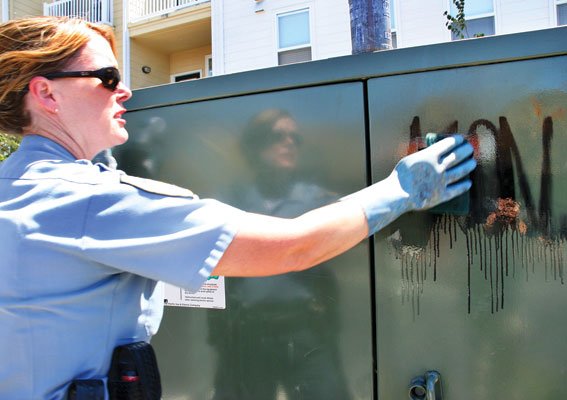After months of fighting a losing battle with vandals, police
have added a few new tools to their belts that may turn the
tides.
a conversation between the police officer in charge of cleaning
up graffiti and a north Gilroy resident who wants to learn more and
help.
After months of fighting a losing battle with vandals, police have added a few new tools to their belts that may turn the tides.
A new Web based graffiti tracking system is helping police agencies in Santa Clara County link cases to launch a regional attack on a problem that’s hitting the entire Bay Area. Instead of investigating cases independently, agencies can tap into each other’s systems to gather information when graffiti vandals strike.
And they are striking.
In the first six months of 2008 alone, Gilroy police have made seven more graffiti-related arrests than they did in all of 2007 and have seen a 151 percent spike in graffiti. Cleaning up the problem cost police, parks and other city departments $121,605 in 2007. Although the school district could not put a specific amount on the cost of graffiti by press time, newly appointed Deputy Superintendent of Business Services Enrique Palacios is working on analyzing the cost to the district. To put the problem in perspective, he said his previous employer, New Haven Unified School District – a district only slightly larger than Gilroy Unified School District, spent $250,000 annually on graffiti abatement in the form of paint and salaries.
With skyrocketing numbers impacting taxpayers, police are working smarter to catch the vandals.
Police Chief Denise Turner plans to partner with the Gilroy Chamber of Commerce to educate business owners about a new technology system being piloted by her former employer, the King County Sheriff’s Office in Seattle. With the help of local businesses, she hopes to install cameras hooked up to motion detectors around the city to deter crime.
“There are businesses getting hit every day,” she said. “They’re sick of it. We’re sick of it.”
“The technology does exist,” she said. “We need all this stuff but we don’t have the money.”
She estimated that a high-end camera would cost about $2,000.
While police are working the technology angle, a faithful band of volunteers led by Community Service Officer Angela Locke-Paddon are doing the grunt work, scrubbing away the problem, one careless scrawl at a time.
“You have to keep fighting,” said Marv Thomas, 77, who has been volunteering elbow grease hours for the last 25 years. “I’m going to keep fighting until I go down in the casket.”
Contrary to popular belief, the majority of graffiti in Gilroy is unrelated to gang activity, Locke-Paddon said. Only 15 percent of all graffiti in Gilroy is gang-related, according to police statistics. Thirty-four active tagging crews contribute the other 85 percent.
“Tagging crews are not associated with any criminal activity other than vandalism,” Locke-Paddon said.
Police aren’t just arresting juveniles up to no good, either. Five adults were arrested in connection with graffiti in 2007 and three so far in 2008.
Anthony Robledo, 26, Edmundo Aviles, 27, and Rogelio Baltazar, 25, were arrested in December for vandalizing buildings on the 300 block of First Street. The trio was convicted on charges of vandalism and were sentenced to jail time and fines. Robledo was sentenced to 120 days in county jail and restitution of $1,220. Aviles was sentenced to 204 days in county jail and restitution of $1,220. Baltazar was sentenced to 120 days in county jail and restitution of $9,043.
Turner guessed that adults were being arrested for more gang-related crimes while juveniles were causing trouble out of boredom.
“Graffiti is the gateway to other crimes,” she said.
From indecipherable scribbles to six-foot-tall block lettering, graffiti is a pervasive problem in Gilroy. In addition to likely targets such as alleys and overpasses, the nuisance can be seen in tidy, middle-class neighborhoods like the one Locke-Paddon patrolled Tuesday afternoon in north Gilroy. Almost every post office box bore the insignia of a local tagger.
“I clean them, they tag them, I clean them, they tag them,” she said.
Taking into account the expenses involved in replacing federal property, the vandalism that seemed like a $5 offense could become a felony, she said. After days of baking in the sun, the greasy ink used to leave the crude markings required extra scrubbing to remove.
Resident Scott Valkenaar approached Locke-Paddon as she snapped on a pair of gloves and uncapped a can of solvent to ask how he can help.
“Don’t confront them,” she advised him. “Call 911. Be a good witness.”
While it’s difficult to catch vandals in the act, eyewitnesses reporting the crime can help by giving police accurate descriptions of the suspect’s clothing or features, she said.
Police and volunteers ventured several guesses as to the cause for the increase in graffiti.
“Why do kids do this?” Thomas said. “Because they haven’t identified who they really are and can get attention from their peers for doing this. It makes them feel like they’re important, gives them a sense of worth.”
“I don’t know why it’s up,” Locke-Paddon said. “I’ve been asked that a million times. Poor parent supervision maybe? Kids say it’s boring in Gilroy. They get an adrenaline rush (from vandalism).”
But cheap thrills are diminishing the quality of life in Gilroy.
“This really hurts the community,” Turner said. “We want people to feel safe here. Graffiti creates blight.”
How to volunteer
– Wipe Out Watch meetings – first Wednesday of the month, 12 p.m. Gilroy Police Department
– Report graffiti to 846-0395
– Pick up a graffiti removal kit at the front desk of the police station












